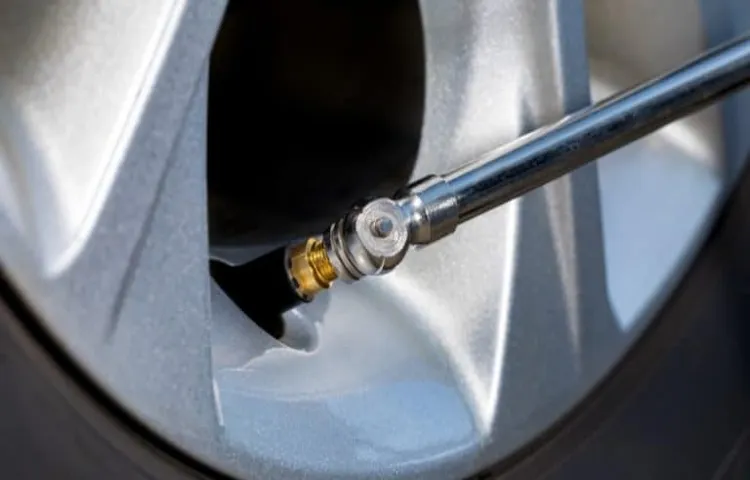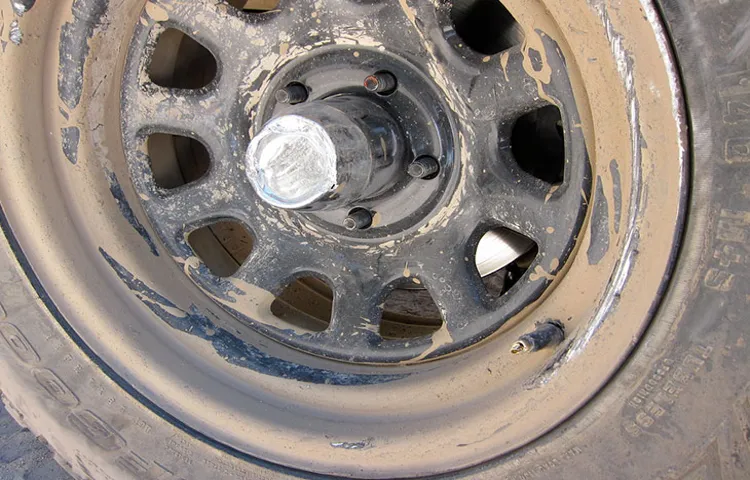Have you ever found yourself in a situation where your tire’s valve stem was broken and you didn’t know how to add air to it? It can be quite challenging to deal with this type of problem, especially if you’re far away from a mechanic. But don’t worry, as we’ve got you covered. In this post, we’ll be discussing how to add air to a tire with a broken valve stem.
The valve stem is a critical component of your tire that controls the air that goes in and out. If it’s broken, air leakage can occur, which can lead to underinflation. As a result, your vehicle’s handling and fuel economy can be negatively affected.
That said, adding air to a tire with a broken or missing valve stem is possible, but you have to be cautious about it. One of the most effective ways to add air to a tire with a broken valve stem is by using a tire inflator. However, this method is only feasible if the valve stem is partially broken, and the opening is still visible.
Otherwise, you’ll need to replace the valve stem first. Another alternative is to use a special tool called a valve stem puller to remove the broken stem and then replace it with a new one. In conclusion, adding air to a tire with a broken valve stem is not impossible, but it can be tricky.
However, with the right knowledge and tools, you can do it successfully. Remember, a well-maintained tire is crucial for your safety on the road, so always pay attention to any signs of damage and address them promptly.
Table of Contents
Assess the Damage
If you’re in a situation where you need to put air in a tire with a broken valve stem, the first thing you want to do is assess the damage. Check to see if the stem is completely broken off or if it’s just damaged. If it’s simply damaged, you may be able to use pliers to twist the stem back into shape and then insert the air pump valve.
However, if the stem is completely broken off, you’ll need to replace the valve stem or use a tire plug kit to repair the puncture. It’s important to note that these are temporary solutions and you should still get the tire replaced as soon as possible to prevent any further damage or accidents on the road. Overall, it’s always best to regularly check your tires for any issues to avoid these types of situations.
Identify the Broken Valve Stem
If you suspect a broken valve stem is the cause of your tire troubles, it’s important to assess the damage before trying to fix the problem. Start by visually inspecting the stem and surrounding area for any visible cracks, splits or holes. These types of damage can often be repaired with a simple patch.
However, if the stem is completely sheared off or warped, it will likely need to be replaced. This may require the use of specialized tools and should be handled by a professional if you’re not comfortable doing it yourself. Keep in mind that a damaged valve stem can lead to a flat tire or even a blowout, so it’s important to address the issue as soon as possible.
By identifying and assessing the damage to the valve stem, you’ll be able to determine the best course of action for repairing or replacing it.

Check for Leaks
If you suspect that you have a leak in your home, it’s important to assess the damage right away to prevent further destruction. Some leaks are visible, such as a dripping faucet or a puddle of water on the floor, but others are hidden, such as a leak in the walls or ceilings. To assess the damage, start by checking for any visible signs of moisture or damage.
Look for water stains on the walls or ceilings or bubbling paint or wallpaper. You can also inspect your flooring for warping or buckling. Next, check your water meter to see if it’s running even when all the taps in your home are turned off.
If the meter is running, it’s likely that you have a leak somewhere in your plumbing system. Don’t wait, call a plumber to fix the leak before it causes major damage. Keyword: leaks
Use an Alternate Air Source
If you’re stuck with a broken valve stem and need to put air in your tire, fear not! You can still inflate your tire using an alternate air source. One of the easiest ways to do this is with a portable air compressor. These small devices can be powered by your car’s cigarette lighter or a battery and will allow you to add air to your tire without the need for a working valve stem.
Simply attach the compressor’s hose to the tire’s valve stem and turn it on. Another option is to use a can of fix-a-flat. This product can be sprayed into the tire and will add sealant to the tire to stop leaks, as well as inflating the tire in the process.
It’s important to note that fix-a-flat is a temporary solution and you should have the tire replaced or repaired as soon as possible. Regardless of which option you choose, it’s important to monitor the tire’s pressure and seek professional assistance if needed.
Find a Nearby Gas Station or Auto Shop
When you’re on a road trip or just driving around town, it’s crucial to have a plan in case your car tire suddenly goes flat. It’s always a good idea to have an alternative air source with you, just in case you can’t make it to a gas station or auto shop. One great option is a portable air compressor.
These nifty gadgets can easily fit in your trunk and come in handy when you need to inflate your tire in a hurry. Plus, they’re much faster than using a hand pump! Another option is to invest in a can of tire inflator sealant, which can temporarily patch up any holes or leaks in your tire. Keep in mind that these products are only temporary solutions, so it’s still imperative to have your tire checked and fixed by a mechanic as soon as possible.
In any case, having an alternate air source available can give you peace of mind and help you get back on the road safely.
Use a Portable Air Compressor
If you’re planning to go on a road trip or visit a remote location with your vehicle, then it’s essential to carry a portable air compressor. In cases where you have a flat tire or need to refill your tires, having an alternate air source comes in handy. A portable air compressor is an economical and efficient device that can help you inflate your vehicle’s tires within a few minutes.
With a compact size and easy-to-use design, you can carry it anywhere you go and never have to worry about being stranded on the side of the road. So, if you’re looking for a reliable way to keep your tires inflated and your vehicle running smoothly, then investing in a portable air compressor is the way to go. It will save you time and money and give you peace of mind knowing that you have a backup plan in case of an emergency.
Apply Pressure Directly to Tire
If you find yourself in a situation where you need to inflate your tire but don’t have access to an air compressor or pump, fear not! There are alternate air sources you can use to get the job done. For instance, you can apply pressure directly to the tire using a bicycle pump or even your lungs. While this may take a little bit longer compared to using an air compressor, it is a viable option when you are in a pinch.
Just make sure to check the recommended PSI for your tire beforehand and use a pressure gauge to make sure you aren’t overinflating it. Once you’ve reached the right pressure, quickly remove the pump or valve to prevent the tire from losing air. By using this method, you’ll be able to get your tire inflated and ready for the road in no time!
Replace the Valve Stem
Have you ever found yourself with a flat tire and a broken valve stem? Don’t despair! You can still get your tire inflated and get back on the road, but it will require replacing the valve stem. To do this, you’ll need a valve stem remover tool and a replacement valve stem. First, remove the old valve stem using the remover tool.
Next, take the new valve stem and insert it into the valve hole, pushing it all the way down until it’s secured in place. Now you’re ready to inflate your tire as you normally would. It’s important to note that a broken valve stem can be a sign of an underlying issue with your tire, such as damage or wear.
It’s always a good idea to have a professional inspect your tire to ensure that it’s safe to drive on. But if you’re in a pinch and need to get your tire inflated quickly, replacing the valve stem is a simple solution. So, go ahead and take charge! Replace that valve stem and hit the road again.
Remove the Tire
Removing a tire to replace a valve stem requires a few steps, but it’s a relatively simple process. Start by loosening the lug nuts on the wheel with the flat tire, but don’t remove them just yet. Then, use a jack to lift the car and place jack stands securely under the vehicle.
Now, you can remove the lug nuts and take the wheel off. Next, use a valve stem remover to unscrew the faulty valve stem from the wheel. Take note of the orientation of the old valve stem so you can install the new one correctly.
Once the old valve stem is removed, insert the new one and hand-tighten it before using a valve stem tool to tighten it all the way. Once the new valve stem is in place, you can reattach the wheel and tighten the lug nuts in a star pattern to ensure equal pressure on the wheel. Finally, lower the vehicle and use a torque wrench to tighten the lug nuts to the manufacturer’s recommended settings.
With a new valve stem in place, your tire should hold air and be good to go.
Replace the Valve Stem
If you’re noticing that your tire pressure keeps dropping, it might be time to replace the valve stem. The valve stem is a small, but crucial component of your tire that allows air to enter and exit. Over time, valve stems can become corroded or damaged, leading to air leaks and low tire pressure.
To replace the valve stem, you’ll need to remove the tire from the rim, let out all of the air, and use a valve stem remover tool to take it out. Then, insert the new valve stem and use a valve stem installer tool to secure it in place. Don’t forget to inflate your tire to the proper PSI when you’re finished! By replacing a worn valve stem, you can save yourself from future headaches and keep your tires in top shape.
Prevent Future Damage
So you have a broken valve stem on your tire, but you still need to put air in it? Don’t worry, it’s still possible! One way to do this is to find a valve stem adapter, which is a small device that fits onto the end of your air hose and allows you to inflate your tire without using the valve stem directly. Another option is to use a tire sealant, which can temporarily plug the hole in the valve stem and allow you to inflate your tire. However, it’s important to note that this is only a temporary fix and it’s best to get your valve stem replaced as soon as possible to prevent future damage.
In the meantime, be proactive and regularly check your tire pressure and overall tire health to avoid any potential safety hazards on the road.
Avoid Extreme Temperatures and Road Hazards
When it comes to preventing future damage to your vehicle, avoiding extreme temperatures and road hazards is vital. Extreme temperatures can cause significant damage to your car’s engine, batteries, tires and fluids, especially during the winter season. It’s crucial to keep your car warm and dry during this time and make sure to regularly check your coolant, oil, and tire pressure levels.
Additionally, road hazards such as potholes, gravel, and uneven pavement can also cause damage to your car’s tires, suspension, and alignment. Regularly inspecting your vehicle’s undercarriage and tires can help you identify and prevent any potential damage. By taking proactive measures to avoid extreme temperatures and being mindful of road hazards, you can save yourself from costly repairs and prolong the life of your vehicle.
Regularly Maintain Tire Pressure
Regular maintenance of tire pressure is crucial in preventing future damage to your vehicle and ensuring a safe and smooth driving experience. When tires are underinflated, they experience more friction with the road, causing excessive wear and tear, and increasing the risk of a blowout. On the other hand, overinflation can lead to reduced traction and uneven tire wear, which can be dangerous in wet or slippery road conditions.
That’s why it’s essential to check your tire pressure regularly, preferably at least once a month, using a reliable tire pressure gauge. It’s also essential to keep in mind that tire pressure can fluctuate with temperature changes, so it’s important to adjust it accordingly. By keeping your tires at the recommended pressure, you can extend their lifespan, improve fuel efficiency, and save money in the long run.
In short, regular tire pressure maintenance is a simple way to ensure your vehicle’s longevity and your safety on the road.
Consider Upgrading to Higher Quality Valve Stems
If you want to prevent future damage to your tires, you might want to consider upgrading to higher quality valve stems. These small but mighty components play a crucial role in keeping your tires properly inflated and safe for the road. However, not all valve stems are created equal.
Cheap or poorly made valve stems can be prone to leaks or even failure, leading to flat tires and other problems down the line. By investing in higher quality valve stems, you can avoid these issues and ensure that your tires are always in top condition. It might seem like a small upgrade, but it can make a big difference in the long run.
So, next time you need to replace your valve stems, consider upgrading to a higher quality option for added peace of mind on the road.
Conclusion
Well, my dear tire troubleshooter, fixing a broken valve stem might seem like a daunting and expensive task, but fear not! With a little bit of resourcefulness and a can-do attitude, you can still pump up that tire and hit the road in no time. Whether you opt for the duct tape and straw method, the rubber band and pliers approach, or any other DIY hack you come up with, just remember to exercise caution and common sense while handling your tires. As they say, where there’s a will, there’s a way, and where there’s a flat tire, there’s always the possibility of a creative fix.
So go forth, inflate, and conquer the highways and byways of life!”
FAQs
What is a broken valve stem in tire?
A broken valve stem in tire refers to a situation where the valve stem, which is responsible for inflating and deflating the tire, is damaged or broken.
Will a broken valve stem affect the tire’s performance?
Yes, a broken valve stem can affect the tire’s performance as it will not be able to maintain proper inflation, which can lead to poor handling and increased risk of a blowout.
How do I know if my valve stem is broken?
You can inspect your valve stem for visible damage, such as cracks or breaks. You can also check for air leaks by filling the tire with air and then using a soap and water solution to identify any bubbles at the valve stem.
Can I still inflate a tire with a broken valve stem?
Yes, you can still inflate a tire with a broken valve stem by using a special tool called a valve stem extractor to remove the broken stem and replace it with a new one.
Is it safe to drive with a broken valve stem?
It is not recommended to drive with a broken valve stem as it can lead to low tire pressure and potentially cause a blowout or loss of control while driving.
How much does it cost to replace a broken valve stem?
The cost to replace a broken valve stem can vary depending on the make and model of your vehicle, but typically ranges from $50-$150.
Can a broken valve stem be repaired instead of replaced?
In most cases, a broken valve stem cannot be repaired and must be replaced with a new one for safe driving.



